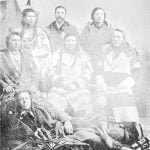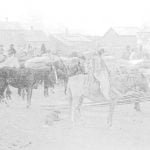Flathead Agency
Report of Special Agent Horatio L. Seward on the Indians of the Jocko reservation, Flathead agency, Montana, December 1890, and January 1891.
Names of Indian tribes or parts of tribes occupying said reservation: 1 Bitter Root, Carlos band, Flathead, Kutenay, Lower Kalispal, and Pend d’Oreille.
The unallotted area of this reservation is 1,433,600 acres, or 2,240 square miles. The reservation has been partly surveyed. It was established, altered, or changed by treaty of July 16, 1855 (19 U. S. Stats., p. 075).
Indian population 1890: Pend d’Oreilles, Pmt nays, and Flatheads, 1,608; Carlos band and Bitter Root Flatheads, 146; Lower Kalispel, 57; total, 1,811.
Jocko Agency

1. John Hill (Te-elish’-st)
2. Antonie (kal-psua-shi’)
3. Tom Adams (Tshia-ma-xap)
4. Peter Roman, US Indian Agent
5. Charlot Victor (S’lem’ge-xè) hereditary Flathead Chief
6. Michel (Tshin-ku-sui’) Interpreter
7. Louis Vandenburg (Kut’som-xe)
The agency is situated in the southwestern portion of the Jocko Valley, which is 10 to 12 miles long and 5 to 6 miles wide. The mountains on either side are heavily timbered with white pine, very large and straight.
The Indians are nearly all Roman Catholics. There is a neat little church at the agency, which is well attended.
Nearly all of these Indians are self-supporting, with good farms well fenced and substantial pine houses. Some, however, live in tepees, especially in summer. Louison, a Flathead or Salish Indian, lives on the agency’s reservation, has a big herd of cattle and horses, and is worth $15,000 or $20,000.
Eight per cent only of the Indians of the confederated tribes of the Flatheads, Pend d’Oreilles, and Kutenays are to a more or less extent dependent upon the government for maintenance. Assistance is also rendered to deserving Indians, especially in the matter of implements, clothing, and tools. The provisions and blankets are mostly issued to the old and decrepit, who are unable to do any hard or active work. Provisions, such as bacon, flour, sugar, and coffee, are in some cases issued to able-bodied Indians who are just preparing for a start in. farming, and until such time as they have harvested their first crop and become to some extent self-supporting.
The Kalispels, who removed from Idaho 2 or 3 years ago, are to a large extent dependent upon the government for assistance. They have planted crops every year, but have been unfortunate, the crops having been destroyed each year by crickets. The fields of their neighbors in the same locality were likewise destroyed. A few of them this season put in two crops, so that should the crickets destroy the first they will still have the other to fall back on. In general, the crops of the reservation have been excellent, those of wheat and oats being very abundant.
The Kalispels are located near the reservation boundary and are still in tribal relations. An extra farmer has been allowed. The whisky which the Indians procure causes them to commit crime, sometimes murder.
The death rate among these Indians has been very heavy of late. Some of them wear parts of citizens’ clothes and many of them speak English.
This agency is in a most satisfactory condition, clean, well kept, and with buildings sufficient for all purposes. The Indians seem contented, and look like a superior people. They want to work.
The young men appear to be hard to handle, especially about Christmas and New Year’s day, but there would be no trouble with them were it not for the bad white men and half-breeds who furnish them with whisky.
Report of Special Agent H. B. Carrington on the Flathead Indians
The Flathead Indians have been friends of the whites since the expedition of Lewis and Clarke in 1805. The Bitter Root valley, more properly called the St. Marys valley, from the river of that name, was their ancestral home, and the present hereditary chief, Carlos, son of the eminent chief, Victor, still resides within 3 miles of the town of Stevensville, Missoula County, Montana, waiting for the government to carry into effect the agreement signed by him and all his people 1 year ago. During the last week of the Fifty-first. Congress the appropriation which President Harrison recommended in a special message in February 1890, for immediate action was made to go into effect after July 1, 1891. The effect of this agreement will be the removal of Chief Carlos and the families still residing in St: Marys valley to the Jocko reservation, 27 miles from Missoula, on the line of the Northern Pacific railroad, where the larger part of the tribe located in 1872.
The early and persistent friendship of this tribe with the whites resulted in a constant and devastating war with the then prosperous Blackfeet, who visited upon the Flatheads their hatred for their friends, the whites. For the purpose of securing more prompt supplies without difficult journeys to remote trading posts Chief Victor early invited settlement upon his lands. More than 50 years ago Father De Smet, an enterprising and noble Christian missionary secured the confidence of this people and founded the Saint Marys mission. Father Ravelli succeeded him, and the venerable Father D’Ast, now at the head of the prosperous Saint Ignatius mission on the Jocko or Flathead reservation proper, succeeded him. The success of the religious teachings of these earnest Christian pioneers was illustrated Christmas Eve, 1890, when fully 700 gathered from all directions and many miles distant to take part in a communion service.
In 1872 Congress initiated a movement to induce the Indians to take lands in severalty and abandon their tribal relations, or, if they preferred, to accept other lands as a reservation, then and since known as the Jocko or Flathead reservation of Montana. Lands were selected upon the watercourses, the best in the valley; but neither Carlos nor his immediate friends would accept the patents which were issued nor leave the lands so assigned. . The vicinity of old Fort Bent, rich in land and immense forests of pine, soon quickened into settlement, and the various tracts were rented by whites or surrounded and penned in by active settlement. The Indians became more and more crowded, while the whites could neither “homestead” nor “preempt” the land adjoining their new homes. The single town of Stevensville, now having 5 churches and an admirable school, controlled but 66 acres, while 80 40-acre tracts patented to Indians surrounded the short business street and its compact settlement.

On the 2d of March 1889, an act of Congress proposed a fresh negotiation with the Carlos band, with a view to their acceptance of the local warrants or their assent to the sale of the lands thus allotted for their benefit and their own removal to the reservation already occupied by a majority of their people. A settlement was effected. The lauds thus surveyed and mapped, with valuation of all improvements, whether made by the Indians or their white tenants, were appraised at more than $97,000. The sales to be made under the act of Congress are not to be at a less figure than the appraisement. Every family, or in case of minors, guardians, executed the papers, so that the United States can give a clear title and be just equally to settlers and the Indians. Fifty-four families executed the agreement, and its execution will leave the entire valley in possession of the whites.
During the negotiations Chief Carlos forcibly emphasized the just claims of his people from time immemorial, and especially his own action dining the Nez Percé war. It is admitted by the whites that with a band of less than 100 of his men he saved the white families of the valley from extermination before Howard and Gibbon could concentrate a sufficient force to meet Joseph and Lookingglass in the field.
The Jocko Reservation
The reservation, shared by the Flatheads and two kindred tribes, embraces about one-half of Flathead Lake within its boundaries. Senate Document No. 70 explains the irrigation begun and the extent of its development still needed. The funds will be ample to give full effect to the declared purpose of Carlos and his people to do good farming in their new home.
The Jocko Buildings, mostly built by the Indians themselves, are boarded, shingled, generally curtained, with well fenced enclosures, and show an intelligent purpose to follow the modes of civilized life. The grain and hayricks are well stacked, bound, and secured, fully as well as with farmers elsewhere. There are some small and miserable cabins, but the tone of improvement and progress is unmistakably apparent. A sawmill, gristmill, and shingle machine, at the agency is liberally patronized, and they buy its use by the toll of logs and grain. They neither beg the aid of these agencies nor hesitate to pay for them. The irrigating ditch is 6 miles long, with 6 flumes, and was built by them by the job at a price per yard, and systematic, self-sustaining industry is well developed.
The year 1889 succeeded a winter with little snow. The streams of St. Marys valley and even of the Jocko and Mission valleys were so poorly supplied at the usual spring melting that the stock and crops alike suffered, and yet there were good cattle and fair crops.
Education
St. Ignatius School, with nearly 200 pupils, its workshops and other accessories, affords a common school education. In penmanship, drawing, and music the proficiency was marked. In decorum, neatness, and application there was little to criticize. The games of the playground were heartily enjoyed without wrangling, and the responses to bell calls from early morning until night were prompt, with very rare exceptions.
Morals
The bane of this and of all reservations so easily accessible is that contact with whites which introduces whisky. The comment of one Indian who had just come from Missoula, where licensed gambling and, drinking saloons run continuously day and night, Sundays included, tells the truth: “You punish us for doing what the white men do and do nothing with him.” Other than this, the Indian left to himself compares favorably with any race in respect to chastity. At present there are few Flatheads who are Wholly Indian. More than three-fourths of the pupils at St. Ignatius show white characteristics. The maturing beard marks its origin, and the changes have been for many years in progress. but among themselves the Indians are not a licentious people.
Citations:
- The statements giving tribes, areas, and laws for agencies are from the Report of the Commissioner or Indian Affairs, 1800, pages 434-445. The population is a result of the census.[↩]


